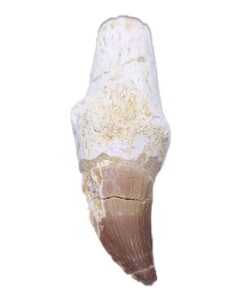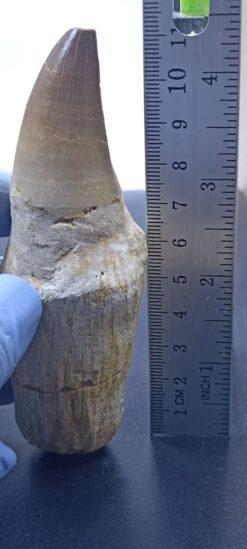Original Mosasaurus Hoffmanni Tooth Rooted 3.7″ Fossil Morocco
$ 346,00
1 in stock
Mosasaur Hoffmanni |
|
| SPECIES | Hoffmanni |
| AGE | Late Cretaceous (~70 million Years) |
| LOCATION | Sidi chennan basin, Morocco |
| FORMATION | Phosphate Deposits |
| SIZE | 3.9″ long |
| CATEGORY | Reptile, Amphibians & Synapsids |
| SUB CATEGORY | Mosasaur |

Hoffmanni was a Mosasaur that deviated from the norm by adopting a new kind of predation. It resembled the early placodont reptiles of the Triassic, like Placodus, by specializing in eating tough-shelled prey such as shellfish, turtles, and ammonites. Its diet was previously speculated based on its teeth and jaw structure until two discoveries in Canada in the early 21st century. These findings revealed the full body shape and diet of Prognathodon. One specimen showed the presence of turtle and ammonite fossils in its stomach, along with a 160cm-long fish, suggesting that while Prognathodon was a specialized predator, it was also opportunistic in its feeding.
Hoffmanni had a robust and heavy jaw capable of withstanding high bite force with powerful jaw muscles. Its teeth were strong and well adapted for crushing, with serrations for destroying protective prey shells and shearing flesh. Hoffmanni also had bony rings around its eye sockets, an adaptation for deep water diving to withstand higher water pressure, especially when diving for ammonites.
The reason for Hoffmanni’s shift towards this diet, when mosasaurs are typically apex predators of other reptiles and fish, remains uncertain. It could have been due to fierce competition for the ecological niche of apex predators, or the declining numbers of large prey animals traditionally associated with mosasaurs, necessitating a need to switch to a different diet. Alternatively, it could have been to exploit an abundant food supply. Another mosasaur, Globidens, also adjusted to this diet with particularly large and rounded crushing teeth in its mouth.
Only logged in customers who have purchased this product may leave a review.

























Reviews
There are no reviews yet.